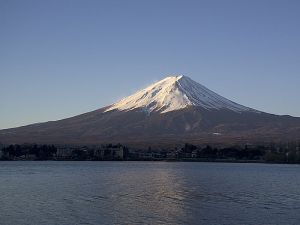Science Centre: Flour Volcano
Interview with
How can you make a volcano? Ginny Smith and Dave Ansell find out, with help from expert volcanologist Tehnuka Ilanko.
Ilanko.
Ginny - Right. So, we've been talking a bit about calderas and how volcanoes get that really distinctive shape. I mean, if anyone says the word volcano, I think most of us get this image in our mind of quite a steep mountain with this big crater in the top with bubbling magma inside. But why are they that shape? Well, it's all down to the physics and we're going to try and recreate that now.
Dave - So, this isn't all volcanoes but we're explaining that kind of classical volcano. So, Tehnuka was talking about the thing which triggers the volcano is a load of magma inside, and it's all under pressure with lots of gases in there. So we're going to model that with a balloon, which I'm just going to blow up now.
Ginny - Okay, so Dave is going to blow up the balloon and that's the equivalent of the gases.
Dave - And the magma. In theory, it should be hot and several thousand degrees centigrade.
Ginny - We thought that would be a bit dangerous, so we're going to stick with a cold balloon for now. Okay, so we've got our chamber full of magma and gases and it's all under pressure, so it's not going anywhere. But that's surrounded by rocks, so we're going to use flour to model that.
Dave - So, this is basically stuff which has been erupted in previous eruptions forming a nice sort of mountain shape and an awful lot of mess, that's one bag of flour...
Chris - At least you can say it's ground.
Ginny - We're not sure we're going to have enough flour here. So, you've now got flour all over your face. Always good in an experiment if you end up covered in it - well, depends what the experiment is! We're going to carry on building our mountain around our chamber of magma and we're going to cover it up completely. So now, this is before it's erupted. So, we've got out nice little mountain there. Now, Tehnuka, can you come and give us a hand with this?
Dave - I feel the volcanologist ought to trigger the eruption. So, Tehnuka is going to take a pair of scissors and go in and try and cut the top of that balloon.
金妮——好吧,这不是那么引人注目的一个explosion as some volcanoes. What you might be able to see is that we've got a sort of crater that's formed. So, where the balloon was, the flour has all fallen in on itself and it's formed a crater, and is that actually how it happens with real volcanoes?
Tehnuka - Well, real volcanoes don't have balloons inside them, but they do have magma and gas that's under high pressure. And when, for whatever reason, it's able to come up and some of its pressure is released. Part of the cool thing about this experiment is that it shows a couple of things. You probably wouldn't have been able to see it, but as the air came out of the balloon, it sort of hollowed out some of the top of the flour volcano. So, when you have a lot of gas or magma escaping at high energy, it can excavate a little bit of space around the crater. The other thing you see is that as the balloon deflates, you end up with an empty space and that collapses in on itself. There's no pressure pushing out on the volcano to hold the sides up, and so it collapses.
Ginny - Thank you very much.
Chris - So, any questions for Dave or Ginny about flour volcanoes?
Ewan - I'm Ewan from St. Neots and my question is, if a volcano erupted on an island with mainly the volcano, how would it devastate the people on the island?
Tehnuka - So, there are a lot of different effects that a volcanic eruption can have on people. Some of the most damaging eruptions are those that send a lot of ash and gas, all mixed up in a very fast, turbulent flow down the side of the volcano. These are called pyroclastic flows. These can be hot. They can be very fast. They're very powerful and some of the biggest loses of life have been as a result of these.
Dave - And you can also get - some of these gases can be quite poisonous. So, wasn't there huge problems in Iceland a few hundred years ago when lots and lots of hydrogen fluoride was given out and most of it - a large proportion of the Icelanders - died because of these poisonous gases which got kicked out.
Tehnuka - Yes, there was this laki fissure eruption which went on for a long time and the thing with these acid gases is that they can also damage the environment. So, there was a lot of crop failure, a lot of livestock that died.







Comments
Add a comment